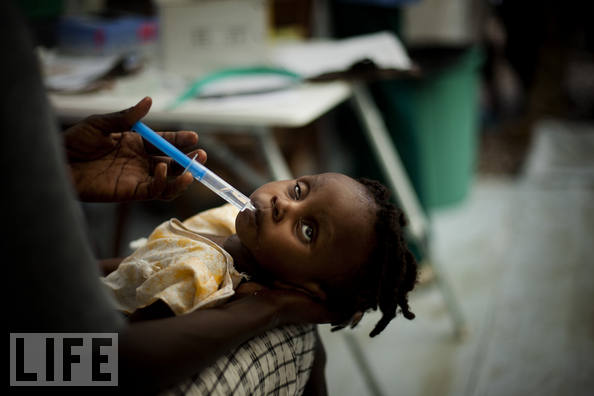
Oct. 22: A man suffering from cholera symptoms lies on the floor of the hospital in Marchand Dessalines, Haiti.
A United Nations-sponsored report into the causes of a deadly cholera outbreak that ravaged Haiti in the wake of its disastrous 2010 earthquake has discovered a culprit — the U.N. itself.
The 32-page report, prepared by an independent panel of medical experts at the behest of U.N. Secretary General Ban Ki-moon, clearly states that the source of the epidemic was most likely a camp for U.N. peacekeepers in Haiti, whose human waste was dumped by independent contractors into an unsecured pit that was susceptible to flooding in heavy rainfall.
That conclusion, the report notes, mirrors “a commonly held belief in Haiti” virtually from the moment the outbreak began.
But the report buries that central finding under a welter of circumstances that caused investigators to conclude that the outbreak, which is ongoing, “was not the fault of, or deliberate action of, a group or individual.”
The cholera epidemic, which is still ongoing, has killed some 4,500 Haitians through severe diarrhea and dehydration since its outbreak in October 2010. There had been no previous cholera outbreak in Haiti for nearly a century. the report confirms that the specific cholera bacteria involved in the Haitian epidemic are a variant first detected in Bangladesh in 2002, which is even more toxic than other cholera strains found in South Asia.
As the report also notes, military contingents from Bangladesh and Nepal were among members of the United Nations Stabilization Force in Haiti (known by its French-language acronym of MINUSTAH) stationed at U.N. peacekeeping camp Mirebalais, close to the initial outbreak. An additional contingent of 60 Bangladesh police officers was also stationed at Mirebalais between September and October 2010.
None of the U.N. personnel were recorded as cholera cases, but the bacteria, which is usually spread through water, can exist in small numbers in the human digestive tract until it hits a rapid-breeding environment.
According to the report, the MINUSTAH camp at Mirebalais was just such an environment. Water piping around the main toilet and showering area of the camp was “haphazard,” with “significant potential for cross-contamination through leakage from broken pipes and poor pipe connections.” Some of the pipes ran over a drainage ditch that fed into a tributary of the Artibonite River, Haiti’s largest, which subsequently became the main artery of the water-borne epidemic.
In addition, sewage from the camp, along with two other MINUSTAH facilities, was trucked by a contractor to an open and unfenced septic pit, in an area that was susceptible to flooding and overflow in wet weather that enters the same river tributary system.
Click here to view the full report
As the report notes, “there is significant human activity — including washing, bathing, drinking, and recreation,” along the tributary system, while the Artibonite River itself is “extensively used for irrigation and agricultural purposes” through a canal system.
The experts reported that by the time they made an inspection of the Mirebalais area, long after the epidemic began, “the battalion stationed at the Mirebalais MINUSTAH facility had made substantial improvements in the sanitary conditions.” But even so, “conditions were not optimal and additional work was needed” to prevent further contamination.
The expert report knocks down any notion that the “explosive” cholera outbreak came from a natural environmental source, or an indigenous Haitian mutation of the deadly bacteria. But it argues that local factors played an important role: “The introduction of this cholera strain as a result of environmental contamination with feces could not have been the source of such an outbreak without simultaneous water and sanitation and health care system deficiencies.”
The combination of factors led the experts to their no-fault conclusion. and in any case, they argue, “the source of cholera in Haiti is no longer relevant to controlling the outbreak.” in general, they propose new hygiene precautions for future U.N. missions, and a big investment in safe pipes and drinking-water facilities in Haiti.
The U.N. predicts that an additional 400,000 people in Haiti may contract cholera this year as a result of the outbreak. other estimates have run twice as high.
Meantime, at the U.N., spokesman Martin Nesirky says that Secretary General Ban will consider the report carefully. Nesirky said the U.N. chief will convene a task force to study the findings and recommendations to ensure they are dealt with promptly.
George Russell is executive editor of Fox News
Tags: stabilization force, cholera epidemic, independent contractors, medical experts, cholera outbreak <BR/>
Tags: ban ki moon, cholera bacteria, cholera cases, cholera epidemic, cholera outbreak, cholera symptoms, deliberate action, independent contractors, independent panel, initial outbreak, marchand dessalines, medical experts, members of the united nations, south asia, stabilization force